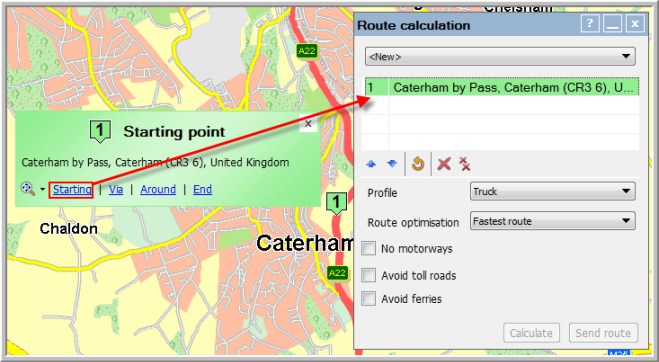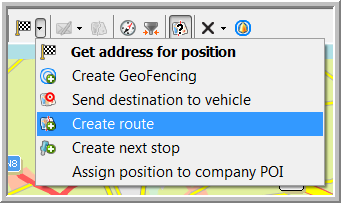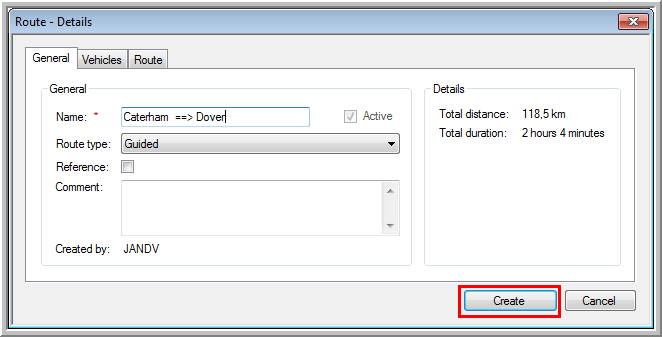 Address per address
Address per address|
ROUTE CALCULATION |
There are two possibilities to create and calculate a route:
 Address per address
Address per address
It is possible to create and calculate a route between addresses on the map.
(Find out how to search for an address on the map.)
Once you have found an address for your route, you can assign a route point to it. From the moment you click the Starting button, to set this address as the first point of your route, the "Route calculation" window will open. Make sure you set a starting point and an end point to be able to calculate the route.

 With the Create route button
With the Create route button
It is also possible to create a route with the Create route button in the drop-down menu under "Get address":

As long as this function is activated, the user can add route points just by clicking on the map. The first point is automatically set as "Starting point", while the last point has to be set by the user as "End point". All points in between can be set as hard or soft via points.
There are four different kinds of route points:
Starting: Green address box which indicates the starting point of the route.
Around: Blue address box containing a so-called "soft via point". The dispatcher can give a radius to this point through which the driver has to go to complete his route. This can be very useful to urge the driver in a certain direction, for example to avoid dangerous places, road works, etc.
Via: Yellow address box representing a so-called "hard via point", a point where the driver actually has to stop and perform an activity.
End: The red address box represents the end point of the route.
It is also possible to select the ferry or train you want to take, in order to combine several means of transport in the route calculation.
|
When selecting a route point in the list, it will flash on the map for an easy localisation of the point. |
The drop-down list on top of the window allows you to select an earlier created and sent route. A sent route automatically appears in this list. Next, it is possible to select a TLN profile (if activated) to obtain a uniform route and cost calculation. You can also choose the Car profile. When the "Truck map data" functionality is activated, you have 4 default truck profiles, instead of the TLN profiles. However, it is always possible to create your own truck profiles, where you can choose to hide or show the eco tax, etc.
Under route optimisation, you can choose the fastest or the shortest route (not possible with TLN profiles).
|
Note that these settings are saved in the personalised view, NOT in the route itself. As a result, it is possible that the calculated route on the map does not fully correspond to the route in the "Route management" screen.
How to switch route points?
Select the route point (multiselect with CTRL button) and click the Move up or Move down arrow. If, for instance, "M25" is selected and moved up, this address will become the starting point and therefore change into a green address box. Click the Calculate button to recalculate the route.
|
|
Move up |
Move the selected address up in the list. |
|
|
Move down |
Move the selected address down in the list. |
|
|
Close route point |
Delete the selected route point from the list. |
|
|
Close all route points |
Delete all route points from the list. |
|
|
Revert route |
Revert the route: Starting point becomes end point, etc. |
|
|
Copy route |
Copy an existing route. |
Under these buttons, there are three checkboxes (not available with TLN profiles):
- Avoid toll roads
- No motorways
- Avoid ferries
In the bottom left corner of the window, the number of kilometres between the starting and end point is shown, as well as the estimated time (based on truck speed) necessary to get from the starting to the end point.
If the route goes over the sea, the number of kilometres and the average ferry time are shown.
If there are toll costs (vignettes ...) and eco taxes to be paid, these are shown per country in the respective currency.
In the bottom right corner of the window, a Calculate button is provided. The route will be calculated according to the order in which the addresses were entered in the list. If the user has sufficient rights, he can send the calculated route to a vehicle, by clicking on the Send route button and selecting the recipient(s). The following window opens:

In the "General" tab page, you can:
Change the name of the route. Deactivating the route is only possible in the "Route management" screen.
Set the route as a "Monitored" route. This means that the route points must be followed in the right order.
Set the route as a "Reference" route.
In the "Vehicles" tab page, you can add or delete vehicles.
In the "Route" tab page, it is possible to edit the name of the via points by double-clicking on the name.
The button at the bottom of the window changes in function of the route:
|
when creating |
a new route with vehicles |
|
|
|
a new route without vehicles |
|
|
|
||
|
when updating |
a route with vehicles |
|
|
|
a route without vehicles |
|
Other useful routing functionalities:
Route management under Settings > Management > Routes
Convert a historical route to a route that can be sent to a vehicle
Filter routes on the map
Toll costs in the route calculation